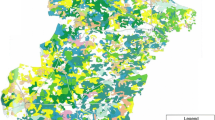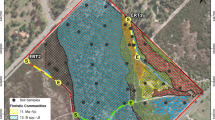Abstract
Thorough soil–geobotanical studies have been performed on a key plot located in the deserted steppe subzone of the light-chestnut–soil zone within the physicogeographical region of the Northern Sarpinskaya Lowland, Kalmykia, along a 64-m-long profile with coupled analysis of microrelief, vegetation, soils, and remote data (detailed Quickbird image). Geobotanical plots, soil trenches, and holes 1–2 m deep have been established along the profile at 1-m intervals. Analysis of the data has showed a close correlation of soils with plants communities (r = 0.72) and loose correlations of these parameters with microrelief (r = 0.42 and r = 0.36, respectively). Some species―Falcaria vulgaris, Limonium caspium, Agropyron desertorum, Stipa lessingiana, Artemisia lerchiana, Festuca valesiaca, and Tanacetum achilleifolium―are never seen on crust solonetzes; the first four species are also never found on shallow solonetzes, and the first two species are never encountered on solonetzic soils. Other species―Kochia prostrata, Artemisia pauciflora, Anabasis aphylla, and Bassia sedoides―are mainly confined to shallow and crust solonetzes and are rarely found on other soil types. The mowing data are well correlated with the normalized difference vegetation index (NDVI) (r = 0.77). The status of vegetation reflected by the NDVI value on the image is clearly determined by edaphic conditions, primarily the soil variety.
Similar content being viewed by others
References
Banonova, V.A. and Gorbachev, S.A., Rastitel’nyi mir Kalmykii (Flora of Kalmykia), Elista: Kalmizdat, 1977.
Budina, L.P., Types of solonchak complexes, in Pochvy kompleksnoi ravniny Severnogo Prikaspiya i ikh meliorativnaya kharakteristika (Soils of Complex Plain of Northern Caspian Region and Their Meliorative Characteristic), Ivanov, E.N., Ed., Moscow: Nauka, 1964, pp. 196–258.
Borlikov, G.M., Natural zonation of Russian Caspian region and its prospective use, Ekol.-Geogr. Vestn. Yuga Ross., 2001, nos. 3–4, pp. 33–41.
Buyanovskii, M.S., Doskach, A.G., and Fridland, V.M., Priroda i sel’skoe khozyaistvo Volgo-Ural’skogo mezhdurech’ya (Nature and Agriculture of the Volga-Ural Interfluve), Moscow: Akad. Nauk SSSR, 1956.
Cherepanov, S.K., Sosudistye rasteniya Rossii i sopredel’nykh gosudarstv (Vascular Plants of Russia and Adjacent Countries), St. Petersburg: Mir i Sem’ya-95, 1995.
Dmitriev, E.A., Matematicheskaya statistika v pochvovedenii (Mathematical Statistics in Soil Science), Moscow: Mosk. Gos. Univ., 1995.
Doskach, A.G., Prirodnoe raionirovanie Prikaspiiskoi polupustyni (Natural Zonation of Caspian Semidesert), Moscow: Nauka, 1979.
Genezis i melioratsiya solontsovykh kompleksov (Genesis and Melioration of Solonchak Soils), Panov, N.P., Ed., Moscow: Rossel’khozakademiya, 2008.
Myasnikov, V.V., Transformation of properties of solonchak soils after rice cultivation in Sarpinskaya Lowland (by example of Bol’shoi Tsryn leman), Cand. Sci. (Agric.) Dissertation, Moscow: Dokuchaev Soil Sci. Inst., 1974.
Novikova, A.F., Konyushkova, M.V., Novikova, N.M., Klimanov, A.V., and Vyshivkin, A.A., Soil salinization and vegetation of solonchak complexes of Northern Kalmykia, Arid. Ekosist., 2010, vol. 16, no. 1 (41), pp. 46–56.
Khitrov, N.B., The relationship between the soils of solonetzic complexes in the northern Caspian Lowland and the local microtopography, Eurasian Soil Sci., 2005, vol. 38, no. 3, pp. 237–249.
Khitrov, N.B., Rukhovivh, D.I., Kalinina, N.V., Novikova, A.F., Pankova, E.I., and Chernousenko, G.I., Elektronnaya versiya karty zasoleniya pochv masshtaba 1: 2.5 mln. (Digital Map of Soil Salinization, Scale 1: 2 500 000), Moscow: Pochv. Inst. im. V.V. Dokuchaeva, 2003.
Khitrov, N.B., Rukhovivh, D.I., Kalinina, N.V., Novikova, A.F., Pankova, E.I., and Chernousenko, G.I., Estimation of the areas of salt-affected soils in the European part of Russia on the basis of a digital map of soil salinization on a scale of 1: 2.5 M, Eurasian Soil Sci., 2009, vol. 42, no. 6, pp. 581–590.
Lavrenko, E.M., Steppes, in Rastitel’nost’ Evropeiskoi chasti SSSR (Vegetation of European Part of Soviet Union), Leningrad: Nauka, 2000, pp. 203–272.
Safronova, I.N., Phytocenotic diversity of desert steppes of the Black Sea–Kazakhstan subregion of Eurasian steppe area, in Geobotanicheskoe kartografirovanie 2001–2002 (Geobotanical Cartography 2001–2002), St. Petersburg: Bot. Inst., Ross. Akad. Nauk, 2002, pp. 44–65.
Vyshivkin, A.A., Vegetation shift of solonchak complex of Northern Caspian region caused by climate fluctuations and grazing cessation, Geogr. Prirod. Resur., 2010, no. 1, pp. 78–82.
Author information
Authors and Affiliations
Corresponding author
Additional information
Original Russian Text © N.M. Novikova, M.V. Konyushkova, S.S. Ulanova, 2017, published in Aridnye Ekosistemy, 2017, Vol. 23, No. 4(73), pp. 13–23.
Rights and permissions
About this article
Cite this article
Novikova, N.M., Konyushkova, M.V. & Ulanova, S.S. Ecological intercomponent relationships in the natural solonetzic soil complex of the Northern Sarpinskaya Plain (Kalmykia Republic). Arid Ecosyst 7, 224–233 (2017). https://doi.org/10.1134/S2079096117040072
Received:
Published:
Issue Date:
DOI: https://doi.org/10.1134/S2079096117040072




